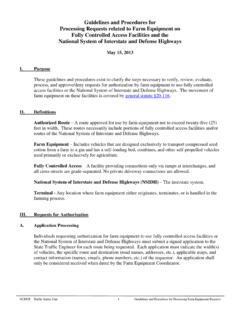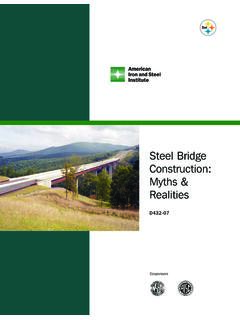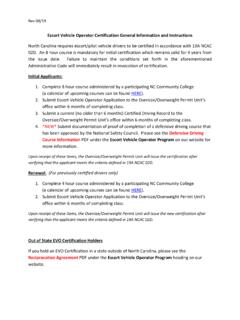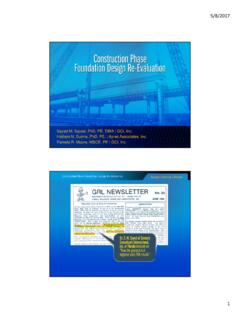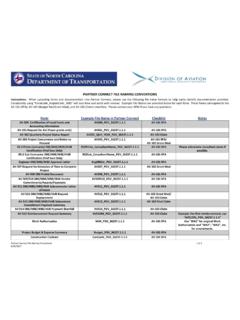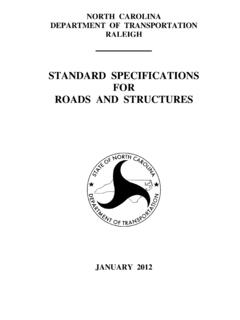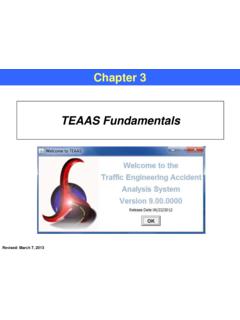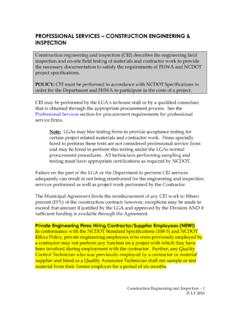Transcription of Report on Western North Carolina Rail Operations and ...
1 Report on Western North Carolina rail Operations and station Right-of-Way AcquisitionNCDOT rail Division April 2002 Page 1 of 9 Report on Western North Carolina rail Operations andStation Right-of-Way AcquisitionNorth Carolina has made significant investments to expand the state s transportation system and providesafe and efficient alternative transportation. As our population continues to grow, it becomes even morecritical to build a seamless, integrated transportation system that includes trains, buses, and regionaltransit, as well as highways, airports and accommodations for bicycles and of the high-speed passenger rail route via North Carolina s populous piedmont crescent will beenhanced through extensions of conventional passenger service to the mountains in the west and acrossthe coastal plain to the southeast.
2 This Report provides more detailed information for consideration ofservice to Western North state of North Carolina financed, built and operated the Western North Carolina Railroad until 1886when it was leased, then sold to the Richmond and Danville Railroad. In 1894, that railroad became partof the Southern Railway Company. Southern Railway took over operation of the Western North CarolinaRailroad in 1896. While regular passenger train service to Asheville and Western North Carolina ended in1975, the area still attracts millions of visitors each year many from cities served by existing Amtrakservice. Increased support for passenger rail service has sparked renewed interest in re-establishingservice to Asheville to enhance economic development and improve the state's North Carolina Department of Transportation (department) first considered extending passenger railservice to Western North Carolina at the request of the Western North Carolina delegation to the GeneralAssembly during the mid-1990s.
3 In 1997 the department reported on five alternatives for extendingpassenger rail service to Asheville and Western North Carolina . Based on an evaluation of eachalternative's projected ridership, revenue production and costs, that study identified service from Raleighto Asheville via Salisbury as the preferred route. The 2000 session of the North Carolina GeneralAssembly directed the Department to re-evaluate Western North Carolina service based on a Salisbury toAsheville route and to develop more detailed cost estimates and conceptual plans. The study was designedto update and expand the 1997 Western North Carolina Passenger rail to $250,000 was appropriated during the 2001 session of the General Assembly for an engineeringstudy to determine the necessary infrastructure improvements and costs of those improvements to providepassenger rail service to Western North Carolina .
4 The Department worked with Norfolk SouthernCorporation to select The Woodside Consulting Group, Inc. to evaluate the improvements needed for theSalisbury to Asheville segment of the Norfolk Southern S-line. The Asheville Area Chamber of Commerce, in conjunction with other regional leaders, formed theWestern North Carolina rail Corridor Committee in March 2000 to promote restoration of passenger railservice to the foothills and mountains of North Carolina and to provide assistance and support to theDepartment. This committee consists of stakeholders and representatives from communities along theproposed route between Salisbury and Asheville. The committee has encouraged each community to forma local task force to provide support for station restoration projects and they have organized and hostedmonthly committee meetings to inform members of the progress and status of the passenger rail on Western North Carolina rail Operations and station Right-of-Way AcquisitionNCDOT rail Division April 2002 Page 2 of 9 Route of the Proposed Western North Carolina Passenger rail ServiceStudy ScopeNorfolk Southern s stated objective for the study is to facilitate implementation of passenger trains whileminimizing interference with their freight trains operating between Salisbury and Asheville.
5 The studydetermined the impacts of the proposed passenger trains on the Operations of Norfolk Southern s freighttrains, identified track capacity required to mitigate the impact of the passenger trains, and estimated thecosts for the physical improvements. In addition, the study identified passenger schedules for theproposed passenger train engineering analysis evaluated the current freight Operations and the required passengerimprovements across the 139 miles of the Norfolk Southern S-line. The number of tracks, length andnumber of sidings and signaling system restrict the capacity of the railroad to accommodate additionaltrains. For instance, the Salisbury to Asheville segment is a single-track railroad with train control signalsalong only two of the 139 miles. To efficiently accommodate passenger and freight trains, train controlsignals will need to be added along the remaining route.
6 Additionally, there are 14 sidings, ranging from2,000 to 13,500 feet long, which allow trains to pass each other along stretches of single-track existing sidings limit train speeds to 15 miles per hour when entering or exiting sidings. The sidingswould need to be upgraded to allow for timely and efficient train S-line gradient varies between to percent between Salisbury and Old Fort and betweenRidgecrest and Asheville. Curvature ranges from 1 to 4 degrees. From Old Fort to Ridgecrest there areabout 11 miles of gradient, ranging from to percent as the line climbs the summit of the BlueRidge Mountains traversing seven tunnels. Curvature in this portion ranges from 8 to 14 degrees. Thereare 192 highway-railroad crossings and 74 bridges or grade separations on the S-line. The steeper thegradient and higher the curvature, the slower the trains can on Western North Carolina rail Operations and station Right-of-Way AcquisitionNCDOT rail Division April 2002 Page 3 of 9 The initial study scope was revised to increase the passenger train speeds to the maximum conventionaltop speed of 80 miles per hour where practical, and to increase the number of passenger trains to two perday per direction.
7 This action was taken to develop an estimate for the minimum travel time and tofacilitate transfers to the state-sponsored Piedmont (Amtrak trains 73 and 74) and Carolinian (Amtraktrains 79 and 80) passenger trains. The department initially requested operating schedules of no more than3 hours and 45 minutes; Norfolk Southern responded with a scheduled run time of 3 hours and the course of the study two key variables changed which also impacted the study: Norfolk Southern revised regional freight Operations to add trains and to initiate scheduled freightservice. In December 2001, Norfolk Southern discontinued Asheville to Greenville, SC service via the Saluda Line and re-routed 10 freight trains per week over the Asheville to Salisbury line,increasing traffic on an already busy stretch of consultant asserts that introduction of passenger service under current conditions would have asignificant adverse effect on Norfolk Southern Operations .
8 Each Norfolk Southern freight train that mustmeet or pass a passenger train could experience delays of 45 minutes to one hour. The study identified 33instances where freight and passenger trains would meet and need to pass each Study RecommendationsThe proposed station stops are: Salisbury, Statesville, Hickory, Valdese, Morganton, Marion, Old Fort,Black Mountain and Schedules for the Salisbury-Asheville Passenger TrainsServiceTrain :45 AM :25 AM :30 PM Trains79 Westbound7:05 PM :15 AM :00 AM :00 AM :15 PM :45 PM :30 PM LineTrains71 Westbound7:35 PM :50 PM for connecting Amtrak trains numbers 80, 73, 74 and 79 assume 20 minutes of travel timereduction following completion of the North Carolina Railroad Improvement Program betweenGreensboro and Raleigh in Infrastructure Improvements Construction projects include installing power turnouts; extending to 10,000 feet and/orrehabilitating 10 sidings.
9 Upgrading seven shorter sidings; upgrading track and bridges toaccommodate higher speed Operations ; and increasing super-elevation and lengthening curvespirals. The estimated cost is $101,400, on Western North Carolina rail Operations and station Right-of-Way AcquisitionNCDOT rail Division April 2002 Page 4 of 9 Installing train signal controls over the miles and modifying or upgrading grade crossingwarning systems will cost an estimated $33,300, total estimated costs for the recommended infrastructure improvements are $134,700,000. AppendixA provides a detailed listing of the proposed Improvement ProgramThe primary purpose of the station Improvement Program is to provide safe, clean and functionalpassenger stations in cities that are or will be served by passenger rail service. The program includes bothrestoration of historic stations and construction of new stations.
10 For the Western North Carolina route,each community must provide a minimum of 10% matching funds, and develop a plan for use of thefacility that serves the traveling public and provides for broader, alternative community Department works with communities along the route to help transfer existing station properties fromthe railroads to the municipality. The communities make a long-term commitment to manage andmaintain their facility. We work with the localities to develop partnerships with chambers of commerce,the development community, transit and intercity bus interests, historic preservation groups, and traveland tourism historic stations are restored in accordance with the Secretary of the Interior s Standards andGuidelines and make use of federal Transportation Enhancement Program funding, as well as otherpublic/private restoration grants.

